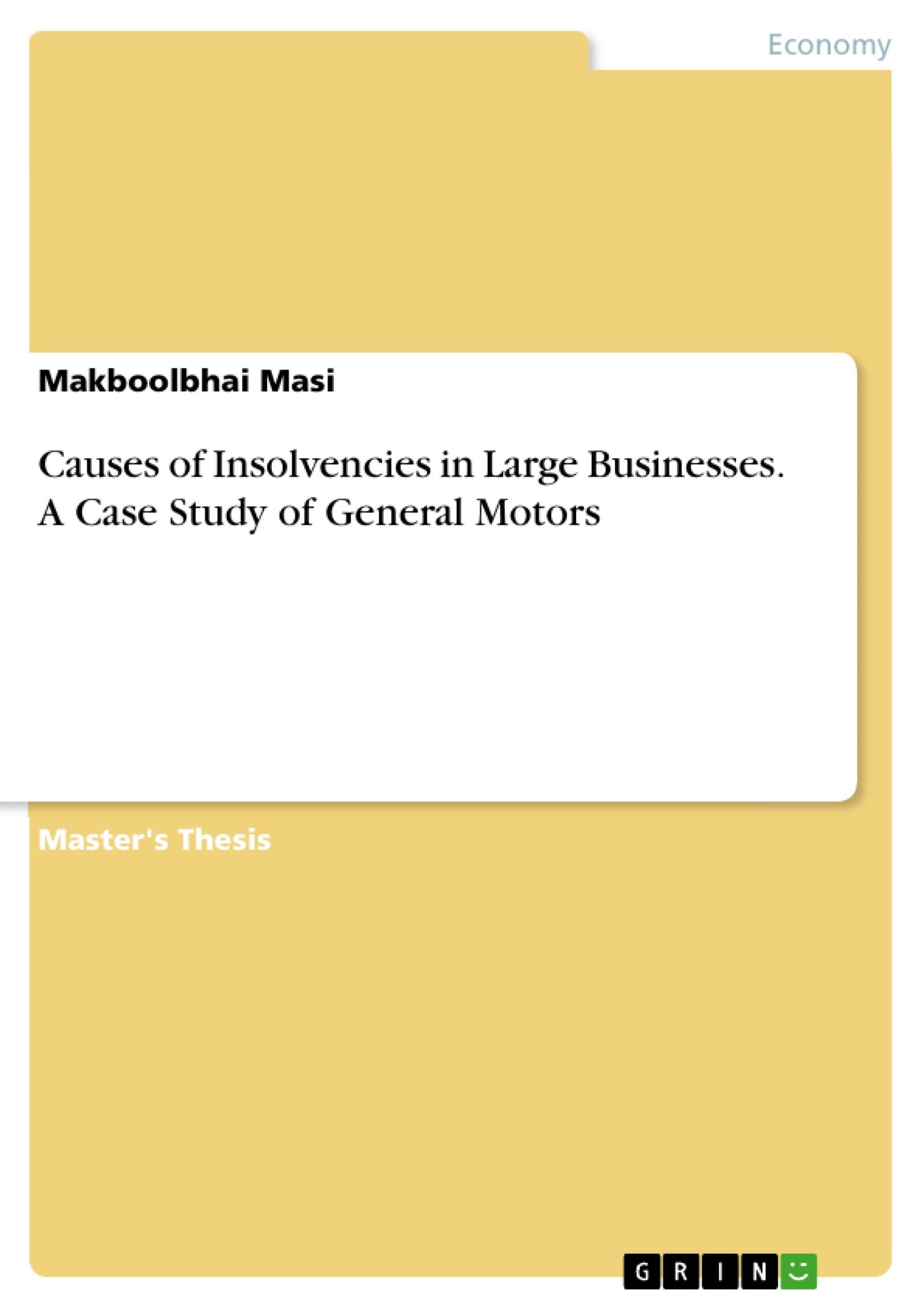This report has intentionally been written for those large organisations which run at risk of failure. World's one of the biggest car and truck manufacturing company, General Motors has been chosen as a case study. The reason behind selection of GM as a case study is due to its 100 years of long history, business operations in 158 countries across the world and filing for bankruptcy petition in year 2009 in an around the time of financial crisis of US. Therefore, financial data for three consecutive years of GM before its application of chapter11 bankruptcy petition have been analysed and compared with its global competitor Toyota for comprehensive judgement. Another investigation is made by analysing the various currencies and important commodity trends against US dollar. This is done to know, how fluctuation in exchange rate of various currencies influence the performance of multinationals. Finally for generalisation, a survey has been carried out on the bases of various literature reviews, financial ratios and currency trend analysis.
In addition to previous researches, which were limited only to financial ratios, this research has been expanded beyond financial sector and included external factors such as economic, capitalism and currency fluctuations.
An insight of various disciplines, which have always been neglected has taken as an empirical and found the diverse conclusion. Whole research prospers through four different segments; from various literature reviews, to financial ratio analysis, examinations of various currencies and commodities and finally questionnaire survey.
Subsequent to research an imperative outcome has been realized. This exploration suggests that for survival of large businesses knowledge of economic is crucial besides financial planning and management. Therefore, large organisation should keep self-regulation to exploit available credit facility and do not exceeds its debts beyond certain agreed limits.While taking strategic decision, it is crucial to analyse base currency and its long term trends.Finally, multinationals should always implement innovation practices for their existence.
Inhaltsverzeichnis (Table of Contents)
- Chapter 1 - Introduction
- Study Background
- Rationale
- Aims and Objectives
- Organisational profile
- Chapter 2 - Literature review
- Introduction
- Impact of economic and financial crisis on large organisations
- Capitalism and market economy
- Strategic management
- Financial management
- Bankruptcy and Insolvency
- Closure and divestment
- Conclusion (summary of the literature review)
- Chapter 3 - Methodology
- Introduction
- Research philosophy
- Data Collection
- Research design
- Study Limitations and conclusion
- Chapter 4 - Findings and Analysis
- Introduction
- Presentation of Data and Analyses
- Comparison between General Motors and Toyota
- Trend analysis
Zielsetzung und Themenschwerpunkte (Objectives and Key Themes)
This dissertation aims to explore the causes of insolvencies in large businesses, using a case study of General Motors. The research delves into financial data from three consecutive years before GM's bankruptcy filing in 2009 and compares it with its global competitor, Toyota. The study also analyzes currency and commodity trends to understand the impact of exchange rate fluctuations on multinational companies. A survey was conducted, incorporating literature reviews, financial ratio analysis, and currency trend analysis, to further investigate the broader implications of the case study. The work seeks to provide insights for large organizations on how to mitigate the risk of insolvency by highlighting the importance of financial planning, strategic management, and economic awareness in a globalized market.
- Causes of insolvency in large businesses
- Impact of economic and financial crises on multinational companies
- Role of financial planning and management in preventing insolvency
- Importance of strategic management and economic awareness in a globalized market
- Influence of currency fluctuations and commodity trends on multinational performance
Zusammenfassung der Kapitel (Chapter Summaries)
Chapter 1 introduces the study background, rationale, aims, and objectives. It also provides a brief overview of the organizational profile of General Motors. Chapter 2 presents a comprehensive literature review on key topics related to insolvency, including the impact of economic and financial crises on large organizations, capitalism and market economy, strategic management, financial management, bankruptcy and insolvency, and closure and divestment. Chapter 3 delves into the research methodology, outlining the research philosophy, data collection methods, research design, and study limitations. Chapter 4 presents the findings and analysis of the research, including the comparison between General Motors and Toyota, trend analysis of key economic indicators, and the results of the survey.
Schlüsselwörter (Keywords)
This dissertation focuses on the causes of insolvencies in large businesses, particularly examining the case of General Motors. The research incorporates financial ratios, currency fluctuations, commodity trends, strategic management, economic analysis, and a survey-based approach to assess the impact of external factors on corporate performance. Key themes include the influence of economic crises, financial planning, and global economic dynamics on multinational corporations. The dissertation aims to provide insights into the strategies and factors critical for the survival and success of large businesses in a globalized and increasingly interconnected world.
- Citar trabajo
- Makboolbhai Masi (Autor), 2012, Causes of Insolvencies in Large Businesses. A Case Study of General Motors, Múnich, GRIN Verlag, https://www.grin.com/document/305268



